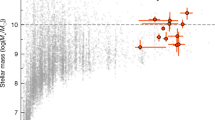Abstract
It has been widely accepted that large amounts of ‘missing’ mass must be present in spiral galaxies to explain both the small-scale and large-scale kinematic observations1. The small-scale data (velocity dispersions in the solar vicinity) refer to the volume within a few hundred parsecs of the Sun, and indicate that 25–50% of the gravitating mass has no detected luminous counterpart2–4. The large-scale data (velocity dispersions and rotation curves) show that this non-luminous component becomes increasingly important with increasing galactocentric distance, and is the dominant mass in the outer regions of galaxies, and in total. It is usually assumed that both the local and global missing mass are the same substance although no plausible candidate for this substance is known. The most widely assumed, and most conservative, candidate is a large population of very low-luminosity M dwarfs. These stars are attractive, both because they exist in large numbers, and because their mass (M) to light (L) ratios are similar to those needed to explain flat rotation curves (M/L ∼ 100–1,000). Finally, they are of very low intrinsic luminosity, and it is therefore observationally very difficult to determine their true space density from blue or visual surveys. We present here new observational results which show that low-luminosity M dwarfs are unlikely to provide the large-scale missing mass, and cannot provide the small-scale missing mass.
This is a preview of subscription content, access via your institution
Access options
Subscribe to this journal
Receive 51 print issues and online access
$199.00 per year
only $3.90 per issue
Buy this article
- Purchase on Springer Link
- Instant access to full article PDF
Prices may be subject to local taxes which are calculated during checkout
Similar content being viewed by others
References
Faber, S. M. & Gallagher, J. S. A. Rev. Astr. Astrophys. 17, 135–187 (1979).
Bahcall, J. N. Astrophys. J. (in the press).
Hill, G., Hilditch, R. W. & Barnes, J. V. Mon. Not. R. astr. Soc. 186, 813–829 (1979).
Schmidt, M. IAU Symp. No. 106 (in the press).
Gilmore, G. & Reid, N. Mon. Not. R. astr. Soc. 202, 1025–1047 (1983).
Reid, N. & Gilmore, G. Mon. Not. R. astr. Soc. 201, 73–94 (1982).
Reid, N. & Gilmore, G. Mon. Not. R. astr. Soc. (in the press).
Gliese, W. & Jahreiss, H. Astr. Astrophys. Suppl. Ser. 38, 423–448 (1979).
Greenstein, J. L., Neugebauer, G. & Becklin, E. L. Astrophys. J. 161, 519–531 (1970).
Reid, N. & Gilmore, G. Mon. Not. R. astr. Soc. 196, 15P–18P (1981).
Liebert, J. & Ferguson, D. H. Mon. Not. R. astr. Soc. 199, 29P–30P (1982).
Author information
Authors and Affiliations
Rights and permissions
About this article
Cite this article
Gilmore, G., Hewett, P. A new limit on the nature of the galactic missing mass. Nature 306, 669–670 (1983). https://doi.org/10.1038/306669a0
Received:
Accepted:
Issue Date:
DOI: https://doi.org/10.1038/306669a0
Comments
By submitting a comment you agree to abide by our Terms and Community Guidelines. If you find something abusive or that does not comply with our terms or guidelines please flag it as inappropriate.



